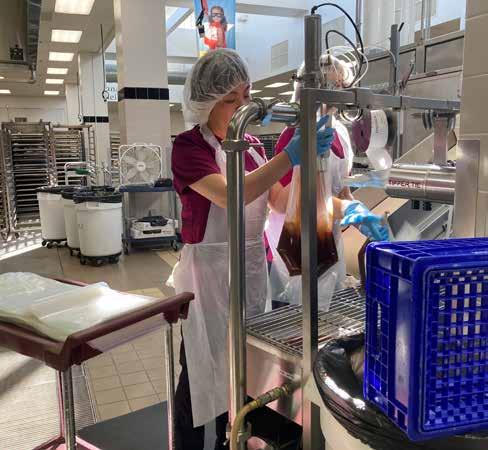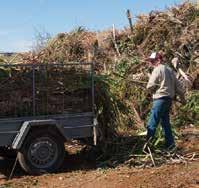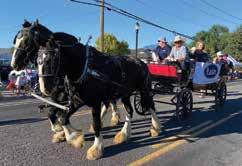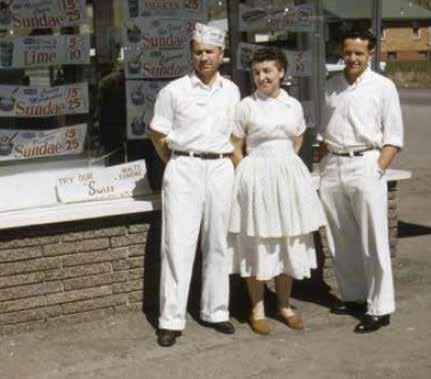Davis County
See Inside...
Moonlight Bike Ride
75-year-old cyclist rides despite health issues Page 9
Utah’s fun food traditions
Funeral potatoes and green Jell-O – only in Utah Page 22

75-year-old cyclist rides despite health issues Page 9
Funeral potatoes and green Jell-O – only in Utah Page 22
By Gail Newbold | andersennewbold@gmail.com
Mike Parsons continues his family’s baking legacy in Bountiful, rising early to craft handmade pastries and breads with oldschool methods.
By 6 a.m., Mike Parsons is a blur of flour and focus – mixing, scoring, and sliding loaves of sourdough into his massive Italian oven. Around him, the bakery hums as his early-rising crew (some clocking in at 3 a.m.) whip up trays of donuts, cookies, cakes, and breads – all before the doors open at 7 a.m.
Parsons opened his bakery in
think my dad made almost every one of the cookies we sell,” said Parsons. “The difference is he used shortening but I use butter. Our Best of State angel food and chiffon cakes are his original made-from-scratch recipes.”
Mixed in with his traditional offerings are an ever-evolving array of pastries that keep patrons interested and excited, such as croissants. “My son Nick traveled the world waterskiing and fell in love with European croissants,” Parsons said. “Over time we’ve added traditional croissants, Kouign-amann, morning buns, sticky buns, chocolate croissants, and ham and cheese croissants to our menu.
– like donuts. Donuts should be eaten within six hours.”
Another way Parsons clings to traditional ways of doing business is his refusal to jump on the delivery bandwagon. He makes an exception for wedding cakes. Otherwise, he expects customers to come to him. And they do.
“I have three generations of people coming into the bakery,” he said. “If you have a good, solid product they’ll keep coming back. Food is memories.”
Another thing Parsons eschews is franchising. “If you mass produce, you have to cut corners,” he said. “I’ve

Mike Parsons, owner of Parsons' Bakery, arrives at work at 6 a.m. to make sourdough bread and other pastries. Photo by Gail Newbold



By Andrew Moffat, DO
Wounds of all types can present significant health challenges, particularly when healing is delayed. These may include pressure injuries, surgical wounds, traumatic wounds, venous ulcers, diabetic foot ulcers, and compromised skin flaps to name a few. Each wound type presents its own complexities and challenges, but fortunately there are many evidence-based techniques and therapies available that can effectively support and promote healing.
As a wound specialist, I try to focus on treating the whole person—not just the wound. At our clinic, we perform a thorough assessment to identify factors that may delay healing, including the wound’s cause, underlying health conditions like diabetes, poor circulation, nutritional status, mechanical stress, and infection. This comprehensive approach helps us develop effective, individualized treatment plans.
One of the more effective treatments for specific wound types is hyperbaric oxygen therapy. Here at the Holy Cross Hospital – Davis, we have 3 individual (monoplace) hyperbaric chambers. These chambers allow us to create an environment with 100 percent oxygen and the added benefit of increased atmospheric pressure. That combination helps drive oxygen deep into the
body’s tissues, suppressing inflammation, facilitating blood flow via new blood vessel formation and in turn healing. It is important to be sure you are treated at a facility accredited by the Undersea and Hyperbaric Medical Society (UHMS), as hyperbaric is not without risk. To be certain all training requirements and safety precautions are met, an accredited facility has been thoroughly vetted to provide the safest and most effective experience for you or your family member.
Another important factor in treating wounds is minimizing the amount of pressure and stress placed on a wound site. For example, foot ulcers have a hard time healing when there is constant pressure being applied to the foot. In such cases we will alleviate that pressure by ordering special orthotics, using a knee scooter, or even placing the foot in a cast to thoroughly offload the wound.
In the clinic we sometimes use products that help recruit stem cells to the area to promote healing. These are called “skin substitutes” and come from a variety of sources. These sources include infant foreskin derived tissue, placental products, and your own native plasma as examples. Special products such as these can promote healing in ways the body may not be able to
accomplish on its own.
An often overlooked but critical component of effective wound care is nutrition. The body requires specific nutrients—especially adequate protein intake—to support tissue repair and promote healing. At our clinic, we provide individualized nutritional education tailored to each patient’s unique needs, risk factors, and underlying conditions such as diabetes. We emphasize the importance of a balanced, nutrient-rich diet, and for patients with diabetes, we offer specific guidance to help manage blood sugar while still meeting the elevated nutritional demands of wound healing.
Wounds can be debilitating, but with the right care and resources, patients with wounds can experience significant improvement in the wound itself, and an overall better quality of life.
Dr. Andrew Moffat is a Certified Wound Specialist Physician (CWSP) and also fellowship trained in Hyperbarics. He sees patients at both the Davis and Lehi clinics.
Learn more about the services, care providers and missiondriven work of the Holy Cross hospitals and CommonSpirit Health at www.holycrossutah.org.

When you need emergency care fast, the closest emergency room is a smart thing to know. CommonSpirit Holy Cross Hospital - Davis offers complete emergency care at our Weber Campus serving as a direct path between feeling scared or uncomfortable and feeling better.
Find emergency care close to you at mountain.commonspirit.org.

At CommonSpirit Health, we make the healing presence of God known in our world by improving the health of the people we serve, especially those who are vulnerable, while we advance social justice for all.


CLEARFIELD—Muffins, meat, soup and the kids’ favorite, Mac n’ Cheese are just some of the products made at the Cook and Chill Central Facility then delivered to all of the schools.
By Becky Ginos becky.g@davisjournal.com
CLEARFIELD—Kids will be back in school soon and along with that comes school lunch. More than 27,000 lunches and close to 5,000 breakfasts are served each day in 93 schools in the Davis School District. Those meals are coming out of the Cook and Chill Central Facility in Clearfield.
Muffins, meat, soup and the kids’ favorite, Mac n’ Cheese are made there then delivered to all of the schools and they all serve the same thing.
“It’s unique in the fact that we have this facility that prepares all of the lunches for all 93 schools in the district,” said District Administrator, Craig Carter. “It was built in 1997 and opened in 1998.”
It’s one of only two centralized centers in the state, said DeeDee Galbraith, production facility coordinator. “We provide food to the Salt Lake School District, Park City, Box Elder and many charter schools.”
The food is USDA inspected daily, she said. “We maintain the highest standard of cleanliness. We have samples that go to the lab quarterly to check for any pathogens.”
Menus are planned out a year in advance, said Galbraith. “We start in September and we’ll be working on the 2025-26 menu. It’s a group effort with the kitchen manager, director, data tech leads in the fa-
cility, etc. who can tell us if it can or can’t be made.”
There’s also some taste testing with the kids, she said. “We have a poll chart that they can put a happy face, sad face or neural face on when they eat. It helps us gauge if the students like the product to determine what works and doesn’t work.”
Mac n’ Cheese is their favorite, Galbraith said. “We also bring in orange chicken and chicken nuggets.”
Muffins are huge, she said. “We make lots of muffins, dinner rolls, ciabatta rolls and frozen cookie dough. We have four rotations of cookies.”
They also cook chili and sloppy joes, said Galbraith. “We make Jell-O and our Oown ranch dressing. We also make pot pie, chicken soup, tomato soup and we’re trying out tuscan soup. Cinnamon rolls are also a big one.”
The facility has a 300 gallon kettle that takes the product to a critical control point at a certain temperature then it’s bagged hot and goes right from bagging into the tumble chiller and it’s cooled immediately there.
There’s also a 300 gallon mixer for making cinnamon rolls then the dough is rolled and cut by hand, Galbraith said. “There are four Revent ovens with racks that can accommodate 30 pounds of product. There is also a packaging machine that packages 90 muffins at a time into a crate.”
Schools also get some pre-made food from distributors but nothing is made at the school, she said. “Distributors deliver fresh produce to the schools.”
Cafe Central & Davis Catering is another unique part of the facility. Anyone can eat there. “They serve breakfast and lunch from 7 a.m. – 10 a.m. and 11 a.m.

to 2 p.m.,” said Galbraith. “You can come in and buy any of the products through the cafe at the register or online.”
They cater within the building (no outside catering) and make food for a lot of weddings, she said. “We make a lot of peanut butter bars and brownies.”
Galbraith said parents don’t need to worry about their children receiving a nu-
tritious meal. “We use all fresh fruits and vegetables every day. Nothing is processed. There are no preservatives in our bread products, we make it all from scratch. We follow all of the USDA requirements for sugar and salt.”
The public is welcome to come and take a tour, she said. “Come and see the process.” l
The City Journal is a monthly publication distributed directly to residents via the USPS USPS and our Bountiful office.
For information about distribution please email hello@thecityjournals.com or call our offices. Rack locations are also available on our website. The views and opinions expressed in display advertisements do not necessarily reflect or represent the views and opinions held by Loyal Perch Media or the City Journals. This publication may not be reproduced in whole or in part without the express written consent of the owner. © 2019 Loyal Perch Media, Inc.
PUBLISHER
Bryan Scott | bryan.s@thecityjournals.com
EDITOR
Becky Ginos | becky.g@davisjournal.com
ADVERTISING EXECUTIVES
Mieka Sawatzki | mieka.s@thecityjournals.com
Lindsay Andreasen | lindsay.a@thecityjournals.com
Jason Corbridge | jason.c@thecityjournals.com
Ryan Casper | ryan.c@thecityjournals.com
Marc Davis | marc.d@thecityjournals.com
CIRCULATION COORDINATOR
Lydia Rice | lydia.r@thecityjournals.com 385-557-1022
Rack locations are also available on our website.
To subscribe to the weekly Davis Journal: subscribe.davisjournal.net
270 S. Main St. Suite #108, Bountiful UT 84010 801.901.7962
EDITORIAL & AD DESIGN
Ty Gorton
Anna Pro
THE CITY JOURNAL
270 S. Main St. Suite #108 Bountiful, UT 84010
Phone: 801-901-7962
MISSION STATEMENT
Our mission is to inform and entertain our community while promoting a strong local economy via relevant content presented across



Diagnosed with Hashimoto’s, Mary Freckleton discovered how eliminating trigger foods transformed her well-being, leading to a new approach to eating and cooking.
By Linda Petersen l.petersen@mycityjournals.com
More than 15 years ago, South Jordan resident Mary Freckleton was diagnosed with hypothyroidism. About two years later, she received a second diagnosis: Hashimoto’s disease. This autoimmune disorder causes the body’s immune system to mistakenly attack the thyroid gland, leading to chronic inflammation that can impair hormone production. Common symptoms include fatigue, weight gain, and sensitivity to cold, but for Freckleton, the most significant symptom was overwhelming tiredness.
Initially, she attempted to manage her condition with medication and a general “healthy eating” approach, but found limited success. Her doctor then suggested a food journal. He provided her with a list of common allergic triggers, instructing her to eliminate them temporarily, then reintroduce them one at a time while meticulously recording how she felt after each food.
The results were illuminating. Through this process of trial and error, Freckleton discovered a complete allergy to gluten. While not lactose-intolerant, she also found she had to avoid dairy products, including cheese and butter, due to a sensitivity to their proteins.
A Culinary Journey: Adapting to a Gluten- and Dairy-Free Lifestyle
Learning to navigate this world of food sensitivity has been a continuous journey of trial and error for Freckleton. When she was first diagnosed, gluten-free and dairy-free substitutes were scarce. Thankfully, the market has improved dramatically, especially over the last three to four years, with many good products now available at her local grocery store. She’s particularly impressed with new vegan cheeses like Vialife, Miyoko’s pizza cheese, and Follow Your Heart (Parmesan).
“Just the past three or four years the really good cheeses have come out, in my opinion, because before, there was nothing that came close to it, and it was gross,” she said. “Babybel even has a plant-based cheese, and it’s good to just bite into it. A lot of vegan cheese has to be melted to taste good.”
Gluten-free bread also presents a challenge. Despite improvements over the years, it still doesn’t quite compare to the homebaked white bread or even packaged Wonder Bread many remember from childhood. The texture is a major problem, Freckleton said. Most gluten-free bread is crumbly and needs to be toasted to help it maintain its shape and prevent it from absorbing liquids from fillings. She particularly likes Franz Bakery’s glu-
ten-free brioche, sourdough, and “Everything Bread.”
“Those are really good,” she said, before adding a slight caveat. “So, okay, it’s good, but it’s not the bread I remember growing up with.”
While various local chains offer gluten-free buns for hamburgers or chicken sandwiches, Freckleton often finds their taste overwhelming. “That’s all you taste when you bite into a hamburger or a chicken sandwich,” she noted. Her tip: The top part of the bun is usually larger, so cut it in half to make it more manageable.
However, Freckleton cautions against relying too heavily on these substitutes, as most are heavily processed.
“There’s so many good choices as far as taste, but I’m not sure that there are good choices for that taste that are less processed,” she said.
Through her travels, Freckleton has even discovered that some of her dairy sensitivity is linked to processing methods used in the U.S. For example, dairy products in Europe often don’t cause her the same issues.
A Texas native, Freckleton grew up on classic Southern comfort foods like fried chicken and corn dogs. Since her mother was a cash-strapped single mom, cream-soup-based casseroles were a staple for stretching food dollars. Over time, Freckleton has developed substitutes for some of these beloved dishes, while others have been permanently eliminated from her diet. She acknowledges there’s no “perfect” substitute, but with a lot of effort, she can sometimes come close.
“If I want to make my mom’s chicken pot pie, which is my favorite, I have to make my own version of the cream of chicken soup and cream of celery soup because that’s what she uses with the chicken and the vegetables,” she said.
“And then I also have to have a pie recipe with all those different ingredients, and it has to be refrigerated. The [non-dairy] butter has to be frozen to grate it in. So, for me to make something that I had when I was younger, and for it to taste close to what my mom made, it is hours and hours of preparation when it used to take an hour to make.”
Sometimes all that work is worth it, but Freckleton freely admits that mostly it’s not.
Embracing Whole Foods and Homemade Solutions
Freckleton has also learned to make her own substitutes at home. She’ll sometimes thinly slice and toast sweet potatoes to use as a substitute for bread in sandwiches. For baking, she relies on Grandpa’s Kitchen and King Arthur’s flours.
“I have really good recipes for pie crust, but it takes like 15 different ingredients to make the flour for one pie, versus just flour from that recipe,” she said.
Mostly, though, Freckleton tries to stick
with whole foods in her diet. She feels her best when she does and understands that, entirely apart from managing her disease, this way of life is healthier and likely to prolong her life. Ultimately, feeling good and maintaining her health is worth the price she has to pay in terms of what she eats.
The fact that she can now occasionally enjoy treats like Sodalicious’ gluten- and dairy-free cookies and cream ice cream makes her journey more than bearable. As glutenand dairy-free products continue to improve, she hopes one day to be able to enjoy versions of some of the foods she’s sworn off. And if they end up being “close,” that will be good enough for her.
Mary Freckleton’s Favorite Recipes
Mary Freckleton generously shared some of her favorite recipes with the Journal’s readers:
Stellar Pie Crust
(From “Gluten-Free on a Budget” by Chandice Probst & Tana Besendorfer)
Ingredients:
• 1/2 cup brown rice flour
• 1 cup white rice flour
• 1 cup tapioca starch
• 1/2 arrowroot starch
• 1 tsp. xanthan gum
• 1 tsp. gelatin
• 1 tsp. Real Salt
• 1 Tbsp. buttermilk powder (use almond flour for dairy-free)
• 2 Tbsp. sugar
• 1 cup butter, frozen (use Earth Balance, butter-flavored Crisco, or other dairy-free alternative)
• 2 Tbsp. buttermilk (or 1/2 Tbsp. dairyfree milk & 1/ 2 Tbsp. lemon juice)
• 1 egg, beaten
• 1 Tbsp. apple cider vinegar
•3−4 Tbsp. ice water
Directions:
• Use a stand mixer for best results. Remove butter from the freezer.
• Combine the first nine dry ingredients and mix well.
• Grate butter, 1/2 cube at a time, into the dry ingredients. Lightly fluff in butter as you go. After all butter is grated in, mix a few turns until all butter is coated in the flour mixture.
• Add buttermilk, egg, and vinegar, stirring once or twice between each addition.
• Add ice water one tablespoon at a time. Mix together until dough sticks together and has a nice, smooth texture.
• Roll out dough immediately or place in the refrigerator. Dough should be slightly colder than room temperature when you roll it out, but not refrigerator cold.
• Place plastic wrap on the counter surface with the end coming down the countertop edge to help hold tightly in place. With your hands, shape half of the dough into a slightly flattened disc and place on plastic wrap.
• Dust the top of the dough with a very
small amount of white rice flour. Roll out dough in a circular motion to achieve a nicely rounded pie crust that is slightly larger than your pie plate.
• After dough is rolled to the desired size, lift the plastic wrap with dough on it and invert into the pie plate. Reposition as needed and remove plastic wrap. The plastic wrap will be removed cleanly.
• Fill with filling. Get a new piece of plastic wrap and repeat the process for the top crust.
• If you are making a lattice top, roll your top crust as directed. When you have reached the desired size, start cutting strips with a lattice crust wheel (this will make a scalloped edge). Place the smaller pieces on the edges and the longer pieces in the middle. Do not cut off overhang; just fold it into itself to make a nice high edge and crimp the edges to seal using your favorite decorative pattern, such as fluting or using the tines of a fork.
• Brush a tiny bit of heavier cream (or dairy-free butter) on the top for deeper browning, avoiding the edges (this isn’t necessary), and sprinkle with sugar if making a dessert.
• Bake at 400 degrees for approximately 30 minutes or until the crust is golden brown. For a single, unfilled crust, bake for about 20 minutes.
Gluten/Dairy-Free Cream of Celery Soup
Ingredients:
• 1/2 cup cashew milk or dairy-free milk of choice (divided)
• 6 tablespoons cornstarch
• 1/2 cup of chicken broth
• 1/2 teaspoon of poultry seasoning
• 1/4 teaspoon of onion powder
• 1/4 teaspoon of garlic powder
• 1/8 teaspoon of black pepper
• 1/2 teaspoon of celery salt
• 1/2 teaspoon of parsley
• Dash of paprika
• 1 celery stalk, chopped into half slices (slice down middle of stalk then slice both together into slices)
Directions:
• In a glass measuring cup, combine 1 cup of milk with cornstarch. Whisk until smooth. Set aside.
• In a medium saucepan, combine the remaining 1/2 cup of milk with chicken broth, poultry seasoning, onion powder, garlic powder, pepper, celery salt, parsley, paprika, and chopped celery.
• Stir cornstarch mixture again until smooth, then add to the saucepan. Stir continuously until it starts boiling.
• Stir and cook for another 1−2 minutes until thickened.
Mom’s Chicken Pot Pie
Ingredients:
Crust:
• If gluten-free, use the stellar pie crust recipe above.
• 1/2 cup of Crisco
• 2 teaspoons of salt
• 2 cups of flour
• 1 cup of water
Filling:
• If gluten-free, use the cream of celery soup recipe above for the first three ingredients.
• 1 can of cream of celery + milk
• 3 tablespoons of flour
• 1 teaspoon chicken base
• 2 cups of cooked chicken or turkey
• 1 bag of frozen mixed vegetables (corn, peas, green beans, and carrots)
• Salt (celery salt if wanted) and pepper to taste.
Directions:
Crust:
• Mix Crisco, salt, and flour together.
• Add water a few tablespoons at a time until the texture is smooth.
• Roll out top and bottom crusts. Place the bottom crust on a 9-inch pie plate.
Filling:
• Preheat oven to 450.
• Mix all of the filling ingredients in a bowl.
• Pour into the bottom pie crust.
• Dot pie with butter of choice.
hour. (If using gluten-free crust and cream of celery soup, the bake time at a lower temperature is less. Bake for 20 minutes). You may need to place tin foil on edges or use a pie edge cover so it does not get too crispy. When lowering the temperature, check.
• Take pie out and let cool.
Mom’s Banana Bread
Preheat Oven: 375 degrees (350 if you live in lower elevation)
Ingredients:
• 5 eggs
• 2 cups of sugar
• 1/2 cup of oil (3/4 if in lower elevation)
• 2 teaspoons of vanilla
• 2 heaping cups of bananas
• 2 cups of sifted flour (A good gluten-free flour blend will work, cup for cup, with this recipe. Grandpa’s Kitchen and Bob’s Red Mill are some.)
• 1 teaspoon of salt
• 2 teaspoons of baking soda
• 1 tablespoon of cinnamon
• 1 cup of nuts (optional)
Directions:
• Stir the first 5 ingredients in a mixing bowl.

• Spray 2 bread-size pans or 1 bread-size and 3 mini bread-size pans. Fill pans a little over half full with batter.
• Bake full size and small at 375 degree s for 30 minutes.

• Mix the next 4 dry ingredients in a separate bowl.

• Pour dry ingredients, a cup at a time, into a mixing bowl with wet ingredients and












• If baking mini, check to see if done (no jiggling of batter when you shake). If there is movement in dough, bake for another 5 minutes. Test again. Repeat the process until done and then take out.





• If full size, reduce heat to 35 degrees and bake for another 20 minutes. Check to see if done (no jiggling of batter when you shake). If there is movement in dough, bake for another 5 minutes. Test again. Repeat the process until done and then take out.
• Let cool. Place a sheet of Press N Seal on the counter so the outside is down and sticky side up. Turn pans upside down on individual sheets and let bread fall out on sheets. Cut a slice if eating after cooled and wrap the rest for later.l

Using the bounty from the garden to make good food for the family.
By Kerry Angelbuer k.angelbuer@mycityjournals.com
Assummer gardens begin producing the best tomatoes of the year and zucchini are growing so quickly that the kitchen is filling up, the question remains how can all this bounty be used to make delicious snacks and dinners for the family? Audry Wendell, who has been living in Bountiful since the turn of the century has a few suggestions for getting all that goodness eaten.
She has gone all out in her spacious yard in the Bountiful flats with a large berry garden full of blackberries, strawberries and boysenberries. She has also nurtured four fruit trees so her family can enjoy apples, peaches, pears and plums in bulk. Wendell grows tomatoes, beets, zucchini, potatoes, corn and squash. Her husband came from a garden-growing and canning family and taught her how it is done. He plants the garden with suggestions from her of what to grow, and then she supports with shared garden maintenance, canning and cooking. She also enjoys growing rosemary, basil, chives and onions which are the spices she uses
the most in her cooking. Wendell and her husband have also produced six children to pass on all this gardening know-how too.
One of her most useful garden staples is the tomato. She has an authentic salsa recipe that she learned from her Mexican friend, Jody Becceril, that can be made in bulk and then frozen for fresh tasting salsa year round. Becceril suggests roasting 15 tomatoes and about eight Serrano peppers until blackened and then pureeing them in the blender. Then add three garlic cloves and a quartered onion to the blender. Add a cup of cilantro, a teaspoon or more of salt and pepper to taste and “chop” in the blender until incorporated. Delicioso!
Tomatoes, cherry and regular, can also be made into caprese dishes. Wendell’s family loves slices of tomatoes on french bread, layered with slices of soft mozzarella and basil, topped with olive oil and the balsamic reduction sauce. They also make “ordeals,” short for hors d'oeuvres according to one of her children, that layer the soft mozzarella balls, with a cherry tomato and basil on a toothpick. The same oil and balsamic reduction is used for these sides at dinnertime. Nothing tastes like fresh garden goodness more than thick slices of tomatoes, new mozzarella, and fresh basil topped with olive oil and balsamic reduction. This beautiful salad can be cut up like a steak.
Zucchinis can be very plentiful and may

even be given out from gardeners overrun with them. Wendell makes a zucchini soup that is a family favorite while being chock-full of vegetables. She got this recipe from her neighbor Jordan McLaughlin.
Zucchini soup
Sauté one large onion in three tablespoons butter.
Add:
8-10 cups cubed zucchini
1 large sweet potato
4 cups chicken broth
Salt and pepper to taste.
This can be cooked in an Instant Pot or a covered pot on the stove until soft. Then puree all. For a creamy version, half of the chicken broth can be substituted with almond milk, coconut cream, half and half or cream added at the end.
Wendell “loves to pick at the peak of freshness” and create healthy meals for her family from her own garden. She sometimes staggers plantings so that things that go together can be ready at the same time. Basil started a little later than the tomatoes, for example, which allows for them both to be at their peak at the same time. She cans what her family will eat year round and even freezes pesto ice cubes. The internet is a great source for using your garden’s output. Put vegetables and fruits that you have in the search bar and recipes using these items will come up. Cheesy Tex-Mex Zucchini Skillet, for example, is available online and is a fresh, hearty meal filling for tacos, burritos or just eaten as a dip with corn chips. l

Cyclists of all ages lit up the night during the whimsical, noncompetitive Antelope by Moonlight Bike Ride on Antelope Island July 11 including 75-year-old Rich Kohler, who defied recent injuries and hospitalization to join the festive 24-mile moonlit journey.
By Gail Newbold andersennewbold@gmail.com
Forthe 31st year, cyclists decked out in lights and costumes enjoyed the magic of biking 24 miles under a starry sky and brilliant moon on Antelope Island.
The Antelope by Moonlight Bike Ride, held July 11, is noncompetitive and has a new theme every year. This year’s was Ride to Oz. It draws a disparate crowd of serious cyclists mingled with beginners, children, teens, and families pulling kids in bike trailers. There were even a few recumbent trikes and a smattering of bison.
Seventy-five-year-old Rich Kohler from Provo joined in the fun for his first time at last month’s event that drew throngs of cyclists.
“People really got into the spirit of things,” he said. “All the bikes were required to have lights front and back but some peo-
ple also lit up themselves. One woman was wearing blinking earrings and shoes. Some people had Christmas lights on their bikes.
“There was so much camaraderie,” Kohler said. “We were lined up to ride at White Rock Bay at about 9 p.m. so we had about an hour to wait till it started at 10 p.m. Everyone was so friendly, chatting to each other, people joining into conversations.”
Koler said when he and his two friends turned around at the historic Fielding Garr Ranch to head back, they were stunned to see bikes for what seemed like miles snaking through the darkness toward the ranch.
“It reminded me of a scene in the movie ‘Field of Dreams,’” he said. “We literally could not see the end of the trail of bikers. It was quite a sight. And beautiful to see the moon rise in the east and then sit high in the sky by the time we finished.”
It was only a month ago that Kohler spent five days in the hospital ICU for an unexpected random medical incident.
“It took a while to get my strength back after the hospital,” said the veteran cyclist who rides several times a week and even cycled in the grueling 200-plus-mile LoToJa Race in his 50s. “Only recently have I been able to ride more than a couple of miles and in fact, I crashed on my mountain bike five days before the Antelope Island ride and
feels like I cracked a rib.”
He was biking above Alpine when his front tire went off the trail as he cut across a steep hill, catapulting him down the mountain. “You should see my face,” he said. “I landed in a scrub oak tree on my shoulder and head. I didn’t want to disappoint anyone so I came on this ride anyway.”
Given recent circumstances, he felt grateful to be on the moonlight ride and said he rode faster than he usually does.
“It was really festive and different from what I’m used to,” Kohler said. “I would do it again. It was very well organized with a lot of support. Booths were giving away free bike lights, bug spray and mini water misters. There was food for sale and free Creamies. I’ve heard there can be flies and bugs but I didn’t notice any.”
After the long drive back to Provo, he crawled in bed at 2 a.m. and showed up for work at 9 a.m.
You might say he’s a little crazy. “I think most bikers are,” he said with a smile. l

The original plan had been to swap land with Bountiful City and build a new library across from the current one.
By Becky Ginos becky.g@thecityjournals.com
BOUNTIFUL—It’s been eight years since the Davis County Library board started to discuss plans for several libraries, some that would be remodeled and some that would be new builds. The South Branch Library in Bountiful was on that list. As other libraries were rebuilt or remodeled money continued to be set aside for Bountiful Capital projects.
In 2023, library staff requested formal offers from southend cities for land options to rebuild the South Branch and received offers from Bountiful and North Salt Lake, ultimately selecting the Bountiful site.
The initial plan called for a land swap between the County and Bountiful City for a new building to be built on the land across from the current location. However, at the Library Board meeting held June 23, the group voted unanimously to remodel the existing building instead. “We hired an architectural firm, Modern Out West, to do a feasibility study,” said Davis County Library Director Josh Johnson. “The study determined the overall cost would roughly be the same to rebuild on the site or to build a new building off site.”
Modern Out West has a solid understanding of what the library needed, he said. “Basically all of the systems in the old building were at the end of life. The heating, air conditioning, and roof were from the 60s. If we had to remove the roof they could take care of some of that during the remodel.”

Johnson said the library’s big concern was keeping services available during construction. “If we move forward we’ll have to find a temporary location that can be a hub for staff. Where do you put 100,000 books? The question is how can we continue to provide services and programming that add value to people’s lives?”
Some plans include using other branches or pick up locations, he said. “It could be in a city hall or even a warehouse.”
Anyone who has lived in the area for a long time has probably been to a piano recital at the South Branch, said Johnson. “We want to respect the history of the building, it is well loved. What works stays, we want to give people what they want. We’d like to keep some of the old things.”
The library conducted a countywide public survey in 2022
to get feedback from the community to help them understand what they want, he said. “We had 13,000 respondents. I feel like we got a lot of insights.”
The design of the new building was for 18,000 square feet all on one floor compared to 24,000 square feet with two stories in the old building. “It’s a big building with landscaping, trees and a stream that you don’t have on the south side (new site),” said Trent Smith with Modern Out West.
“It hurts my heart to think about it being demolished,” said one board member. “It's a beautiful site.”
There’s been a ton of work on the new branch for the southern end of Davis County over a long time, years, said Commission Chair and Board member Lorene Kamalu. “It was the architect who revived considering a ‘down to the bones’ remodel.”
Staff with the architect and staff in the library department have worked really hard, she said. “It is important work. Libraries – and especially librarians – can influence lives for good.”
Additionally, library board members prior and current have all been engaged and thoughtful in the process, said Kamalu. “The board members were unanimous with the latest decision to recommend and now it goes before the Board of Commissioners.”
The building needs to serve the public for the next 50 years, said Johnson. “We don’t want residents to feel like we’re just spending a whole bunch of money on an old building. We want something that gives significant benefits and value to residents.”
It’s been a good process, he said. “We’ve done more than our due diligence. We want to do right by the public – that’s our job.”l
From gourmet biscuits to birthday pizzas, local dog bakeries serve up tail-wagging treats.
By Peri Kinder peri.k@thecityjournals.com
Dog
bakeries are popping up all over, catering to man’s best friend. If you’re looking for something as simple as a healthy, organic treat or as elaborate as a birthday cake for your furry friend, these local bakeries will help show your four-legged bestie how much you love them.
Dela’s Doggy Desserts, 1538 W. 7800 South (West Jordan)
Your K9 companion will love the selection of yummy treats at Dela’s Doggy Desserts. The problem is, you’ll want to buy them all! The Doggy S’more features a peanut butter and pumpkin cookie with carob and yogurt topping. Or try the Doggy Donut Pack with four donuts made from sweet potato and oats, topped with cream cheese, peanut butter and carob.
Dela’s also offers a unique outdoor space, which includes a grass play area and a covered patio, to host your pup’s birthday or other special occasion. The shop’s pet boutique sells adorable collars, leashes, bandanas, food bowls and accessories. Plus, there are fun gifts for dog parents including picture frames, key chains and glasses. Visit online at DelasDoggyDesserts.com.
Rebel Paw, 7681 S. Main St. (Midvale)
The popular dog food truck has found a permanent home on Midvale’s Historic Main Street, where pups and their owners can browse for the perfect treat or toy. The bakery features healthy dog-friendly snacks like cupcakes, cinnamon rolls, peanut butter sandwich cookies, dog pies and more. Rebel Paws


makes elaborate cakes in an assortment of designs for adoption day celebrations or any other event.
Pup parents can also customize a bandana, choosing from a variety of fabrics, sizes, colors and patterns. If you’re hosting a dog party, the Rebel Paw food truck is available to book so your puppy and all his friends can enjoy delicious treats. For more information, visit RebelPaw801.com.
Ma & Paws Bakery, 1227 E. 3300 South (Millcreek)
Featuring natural, holistic, organic foods, Ma & Paws Bakery hopes to alleviate many problems affecting pets, including allergies, joint issues, digestive ailments and kidney troubles. The bakery has 20 different flavors of gourmet dog biscuits in four biscuit sizes to suit any dog. One of the bakery’s best-selling items is the custom-made birthday pizza that includes whole wheat dough, tomato sauce, shredded chicken and parmesan
cheese.
Ma & Paws also has an assortment of natural dog foods, vitamins, supplements, toys, collars and chews. For bath days, use the self-serve dog wash for less than $20 or give Fido a Theraclean Dogbubbles bath that deep-cleans her fur. Visit MaAndPawsBakeryInc.com for more info.
Jake’s Bakes Dog Treats (Online)
Kerri Cooper creates fun and original pup snacks with superfoods like pumpkin, turmeric, sweet potato, oats, hemp hearts, flax seeds and blueberries. Doggy favorites include the Bacon & Cheddar Woofles with eggs, the canine cannoli featuring Greek yogurt and cinnamon and Pup Tarts in strawberry or blueberry.
Jake’s Bakes is an online-only shop but Cooper frequently attends farmers markets in Salt Lake, Weber and Davis County, where her fans can pick up a bag of treats for their furry friends. Follow her Instagram page @JakesBakesTreats for her summer schedule. For a complete list of treats, snacks and chews, visit JakesBakesLLC.com.
The Dog’s Meow, 2047 E. 3300 South (Millcreek), 866 E 12300 S. (Draper)
The winner of several Best of State awards, The Dog’s Meow has been operating for nearly 30 years. Now, with two locations, the shop is a pioneer in the healthy dog and cat food industry, bringing quality products to furry friends across the state.
The Dog’s Meow only carries the highest quality products, so customers know the food, treats, supplements and toppers they buy will support their pets’ healthy growth. Pet owners can also purchase safe toys, dental and grooming products, biodegradable poop bags and more. Plus, the DIY dog wash stations help keep puppies clean for an affordable price. Learn more at DogsMeow.com. l

Comcast’s digital program offers low-cost, highspeed internet access.
By Peri Kinder peri.k@thecityjournals.com
Students are heading back to school and reliable internet access is more important than ever. Digital connection is necessary for online learning, enabling connection and collaboration for kids and parents alike. With Comcast Internet Essentials, it’s easy to have the access needed for school, work or staying in touch with friends and family.
Internet Essentials provides affordable, high-speed internet access to eligible households at $14.95 each month. This low-cost option, with speeds up to 75 Mbps, is designed for everyday use that includes online meetings, video calling, digital workshops and more. For those who need higher speeds, Internet Essentials Plus offers up to 100 Mbps for $29.95 per month.
“This program has connected more than 234,000 Utahns to a fast, reliable internet connection,” said Deneiva Knight, External Affairs Director, Comcast Mountain West Region. “In addition to affordable internet and devices, Internet Essentials customers also gain access to free digital skills training and access to millions of free Xfinity WiFi hotspots across the country, including more than 356,000 in Utah.”
Internet Essentials customers can also purchase a lowcost Dell laptop or Chromebook for $149.99, plus tax. Each device has the hardware and software needed to get online right away, which makes it ideal for students, remote workers, or anyone needing a dependable device at home.


To qualify for the Internet Essentials program, customers must participate in qualifying assistance programs, including housing assistance, Medicaid or SNAP. Applicants cannot be an existing Xfinity customer (within the last 90 days) and can have no outstanding balance with Comcast. To learn more, check eligibility or sign up, visit internetessentials.com or call 1-855-846-8376.
Internet Essentials is part of Comcast’s $1 billion initiative to connect people to the internet, create digital opportu-
nity and build a future of possibilities. By expanding internet access and offering digital skills training, Comcast hopes to provide opportunities to people of all ages and income levels.
“For more than a decade, Comcast has stepped up to ensure everyone can stay connected to what matters most,” Knight said. “We believe everyone should be able to connect to the power of home internet. Whether in rural communities or urban centers, we are working to make the internet accessible to all.” l

Lela Christensen is the oldest living member of the Tabernacle Choir at Temple Square. She sang from 19651987.
By Becky Ginos becky.g@thecityjournals.com
Tabernacle Choir at Temple Square’s “Music & the Spoken Word” celebrated the airing of its 5,000th episode on July 13. It was a historic milestone for the choir but it was especially meaningful for a Bountiful woman who was honored during the program. Lela Christensen was recognized as the oldest living member of the choir who sang from 1965-1987. Christensen will turn 99 Aug. 10.
Christensen’s daughter Susan Alldrege also sang in the choir and between them they served for 38 years.
“My first concert was at President Lyndon B. Johnson’s inauguration,” said Christensen. “We sang at all of the inaugurations, Nixon’s and Reagan’s. With Reagan we were on the steps of the Abraham Lincoln memorial. When he came out he parted through the choir and came down to the bottom. The first thing he did was greet us.”

Christensen said she traveled the world with the choir. “I sang at the pyramids and in Mexico, Europe, Asia, Brazil, Canada and the United States.”

Her first experience with the choir was years before during World War II. “My husband Kurt was a soldier and we got married while he was on leave,” she said. “The next day after we were married we decided to go to Music & the Spoken Word. That was the first time I’d seen it. Little did I ever realize that I would sing in the choir.”
Kurt Christensen also had a memorable experience with the program while serving in Japan. “He heard the broadcast while he was on a carrier,” she said. “They crossed the equator and it was Monday there but he realized it was Sunday here. He was a radar operator and he tried to get the broadcast on. He kept trying and on the seventh bounce they got Music & the Spoken Word.”
It had to be in a specific place to pick that up, she said. “If the ship hadn’t crossed that line it wouldn’t have happened.”
five days in port. So she got on a train and came out to California. When she arrived the captain told them to go spend time together.”
When the ship left she stood on the pier and watched him leave, said Alldrege. “He watched her (until they were out of sight).” Kurt passed away at 96 and they had been married for 75 years.
Christensen wrote a book about her experience with the choir “The Spirit of Music: A Missionary Tool.”
• Bible studies
• Monthly game & activity nights
• Sunday school for adults and children 5-12 yrs.


• Women’s ministry
• Men’s ministry
• Grief Counseling
• Wednesday a ernoon prayer ministry
Our service is 11:00 a.m. Sunday

As many other couples during the war, the Christensens married during his leave. “Mom met my dad in high school,” said Alldrege. “They had dated some then he was called out to war. They had talked a little about marriage but when he got leave they decided to get married.”
People were so understanding because of the war, she said. “They only had two to three days to get ready for the wedding. The dress shop opened early so she could get her dress. They had to get the invitations made and out all in one day.”
They had to get a marriage license and the person was locking up the office to go home, Alldrege said. “They asked if he would be able to help them and he did. They ran to the Salt Lake Temple and they were 20 minutes late but they held everything up for them. It was wartime – people understood.”
The next morning after the broadcast Dad had to say goodbye and he left, she said. “(On the ship) the captain saw him scrubbing the deck. When he found out that he’d gotten married he told him to contact his wife because they had another
One experience in particular stands out, she said. “I was serving on Temple Square. A man who was a complete atheist came to a broadcast. He was very touched by Music & the Spoken Word.”
He was crying and confused about how it made him feel, said Christensen. “He came to me and asked about the choir. We talked for a long time about what we believe in. Usually we don’t know the outcome but about a year later I got a letter from him saying that he was baptized and they were going to come back to where it all began.”
Music & the Spoken Word is the world’s longest continuously running network broadcast with more than 6 million people in 50 countries tuning in each week, according to The Church of Jesus Christ of Latter-day Saints.
“‘Music & the Spoken Word’ knows no boundaries in this great world with multiple races and nationalities,” said Church President Russell M. Nelson. “‘Music & the Spoken Word’ is a global resource. Music is the universal language of the Spirit. Music communicates to the heart and soul of individuals in a way that written words cannot duplicate.” l
FAMILY PROTECTION
• Special Needs Trusts
• Guardianships
• Pre & Post-nuptial Agreements
• Adoptions
• Domestic Partner Trusts
• Name Changes
• Pet Trusts
• Asset Protection
PROBATE & ESTATES
• Letters Testamentary
• Formal & Informal Probate
• Intestate Succession (No Will)
• Small Estate A davits
• Survivorship A davits
• Spousal Claims
DISPUTE RESOLUTION
• Mediation
• Elder Care Disputes
• Estate & Trust Disputes
• Elder Exploitation & Abuse
• Estate & Trust Litigation



TRUSTS & WILLS
• Living & Family Trusts
• Simple & Complex Wills
• Trust Administration
• Irrevocable Trusts
• Assist Trustees, Executors & Heirs
• Trust Review Service
BUSINESS PROTECTION
• Corporations
• Partnerships
• Limited Liability Companies
• Non-pro t Organizations
• Buy-Sell Agreements
• Quiet Title Actions
ELDER LAW
• Powers of Attorney



• Guardianships
• Conservatorships
• Living Wills
• Competency Issues
• Medicaid Planning
• VA Aid & Attendance Planning


The first design phase estimate was over budget by $2 million.
By Becky Ginos becky.g@thecityjournals.com
Care of
Davis County (ACDC) houses more than 4,000 animals annually and has been bursting at the seams for quite some time. The current 11,000 square foot facility was built in 1985 and has gone through several renovations. In 2020, Davis County explored the possibility of remodeling the existing facility or building a new one.
The decision was made to construct a new building that would be approximately 32,000 square feet, more than doubling current capacity. The new facility will be built on the current land. However, the project has been cut back slightly due to rising costs.
“The county had a budget of $14 million for construction of the new Animal Care project,” said Davis County Director Facilities Management, Lane Rose. “We hired Construction Management General Contrac-
tor to give us early design phases estimates before it went out to bid. That helps control costs.”
The first design phase estimate was over budget by $2 million, he said. “The commission asked us to reduce the square footage to keep it within budget. Rising construction costs and some tariffs have affected the project.”
The next design phase will reduce some finishes, Rose said. “Instead of doing an interior garage it will probably be an awning. Some office space and clinical vet space will be reduced. There will still be vet space just reduced services.”
There will be no finished flooring, walls, lighting and ceilings in some areas, he said. “It will be a shell most likely used for storage. We’ll reduce where we can and still operate the facility.”
Rose said they are still trying to keep the capacity for animal spaces. “That is still a high priority and needed. The rising population and number of animals in the county have shown an increased amount of animals processed through the facility.”
ACDC is the only animal shelter in the county. It accepts all animals and has a 95%

The latest floor plan for the new Animal Control facility with the reductions and shell space. The building is being scaled back to meet the budget. Courtesy Davis County
live release.
“We’re trying to keep it on track and on budget,” said Rose. “The contractor will go
out to bid on our behalf. That should go out at the first of the year then construction will begin shortly after.” l
KAYSVILLE—The facility will sit between Columbia Elementary and Kaysville Junior High
By Becky Ginos becky.g@thecityjournals.com
The Davis School District and Kaysville City are in the plan-
ning stages of a partnership to build a new gymnasium for Kaysville Junior High that would be a shared use facility between the school and the city. The gym would be a stand-alone building next to the school and not only expand the gym space but also serve as a recreation center for Kaysville City.
“Kaysville Junior High was on the list of projects under the bond passed in 2022,” said Davis School District Architectural Services Director, Bryan Turner. “It was just going to be a gym. We had no plans of partnering with Kaysville. We talked to the city about being a partner with us for Centennial Junior High but when it came right down to it they said no they couldn’t afford it.”
At the June 5 City Council meeting the district came back to the city with a presentation about the Kaysville Junior High gym to discuss partnering on the project.
“This would give them a way bigger gym and other amenities like basketball, volleyball, track and pickleball,” said Turner. “There will also be a multipurpose room for aerobics, yoga, dance, etc. We’re excited to partner with them.”
This is not the first partnership between the district and a city. “It started with Layton City at Central Davis Junior High,” said Turner. “It’s a stand-alone building with a gigantic gym and is being used for parks and recreation. It’s been very successful. We have two others in Layton, Shoreline Junior High and Legacy Junior High that are part of the school. We also have one in Clearfield and one in West Point that is under construction.”
There is not a clean way to attach a building to Kaysville Junior, he said. “There’s no way to set up truck access for food deliveries, etc. The other side won’t work either. Yes it means
the kids have to walk outside to get to it but they’re not the only school to do that.”
The district and city will split the cost on the new building which allows for a much larger gymnasium that benefits both the school and Kaysville. “The cost of the project is $22 million,” he said. “The maximum the city will pay is $10.5 million, but it will probably be less. The district will pay more because we’ll have the P.E. program, locker rooms, etc. for school sports.”
Other spaces will be split 50/50, he said. “There will be shared areas like the multipurpose room and offices. Layton didn’t use the running track so the district paid for all of that. There are loose plans but we will meet in about a week to go over a cost estimate. We’ll have Kaysville Parks and Rec at the meetings in the beginning to get their input.”
The facility will sit between Columbia Elementary and Kaysville Junior High, Turner said. “It’s all district property. The city uses it for its soccer program. It will be multi-use. We’ll probably have to add parking too.”
Turner said the district will use the facility from 7:30 a.m. to 5 p.m. “There will be about a half hour transition period and the city can go in at 5:30 p.m. on. If the city has supervision they could potentially come in early before school starts. That will all be worked out.”
“I’m especially thrilled to share that Kaysville City is joining forces with the Davis School District to build and bring Kaysville Recreation Center to our community on the campus of Kaysville Junior High,” said Kaysville Mayor Tamara Tran. “This project is the result of years of planning, fostering strong relationships with the district, engaging city staff and listening to community feedback.”
This partnership is a huge win for the city’s recreation programs, she said. “Whether you’re a child, an adult, a senior or anywhere in between, this center will have something for everyone. By sharing the costs with the school district, we’re making this happen responsibly while creating a space that brings us all together.”

A rendering of Horizon Junior High in West Point that is under construction. West Point is partnering with the Davis School District to build a gym. When completed, the gym will be the biggest in the district. The proposed gym in Kaysville will be similar in size. Presentation slide DSD
Imagine courts for volleyball, basketball, fitness classes like yoga, high-energy cardio classes, sports training and a yearround running/walking indoor track, said Tran. “I’m especially excited about that. We could even add workout equipment to make it even better.”
It’s going to be a vibrant hub where the whole Kaysville family can stay active and connected, she said. “I’m so grateful to the Davis School District for partnering with us on this and I’m thankful for the support of our City Council to make Kaysville better than we found it. Together we’re building our community for both our schools and neighborhoods.” l

•















Larkin Mortuary’s dedication to the Utah community is deeply rooted in its history and family values. For over 140 years, spanning seven generations, the Larkin family has proudly served Utah families in their time of need. This commitment extends beyond providing funeral services; Larkin Mortuary actively engages with the community by hosting events and giving back through various service initiatives such as the annual Memorial Day Program, golf tournament, Trunk or Treat and Live Nativity.
and Large: 7–8 servings.
By Cindi Mansell c.mansell@mycityjournals.com
In today’s fast-paced world, carving out time for a home-cooked family meal often feels like an impossible task. That’s exactly the problem Beehive Meals set out to solve – and it’s doing so with resounding success.
Founded in 2019 by a Utah mom who understood the daily juggle of work, kids, and life, Beehive Meals was built on a simple mission: make dinner easy again. By offering pre-assembled, freezer-ready crockpot meals, the company has taken the guesswork and stress out of family dinnertime.
Beehive Meals offers a rotating monthly menu with more than 100 options, blending comforting classics with new flavors to keep meals fresh and exciting. Customers can purchase meals one time or sign up for a monthly subscription – with the latter offering a 10% discount. For example, a monthly subscription of regular portion meals costs $206.10 (about $3.44 per serving), compared to $229 for a one-time order. Meals come in three sizes: Small: 3–4 servings; Regular: 5–6 servings;
Each order includes 10 different meals, and although they’re pre-selected, the extensive menu allows for some flexibility across categories like family-style, gluten-free, and macro-balanced meals. The meals are delivered frozen, packed in insulated bags (which customers can keep and reuse), and are designed to be cooked in a slow cooker. However, many can also be adapted for the Instant Pot or stovetop. Meals include a protein base and sauces or seasonings – but not sides – so families can personalize dishes with rice, pasta, salad, or bread. Meals can be stored for up to 12 months, maintaining convenience without sacrificing quality.
As a busy single mom, I wanted to see if all the hype lived up to the reality. My verdict? The simplicity of dropping a meal into a slow cooker in the morning and having a hot dinner ready by evening was a game-changer. Online feedback echoed my experience. One user said, “I’ve used them for over a year and a half – love them!” Another praised the subscription’s flexibility: “You can pause it anytime. It saves me time and money.”
Beehive Meals doesn’t just deliver dinner – they build community. Through their Loyalty Points Program, users earn rewards for ongoing purchases. The company also maintains an active blog with cooking tips and reuse ideas for their insulated bags. Their FAQ section
September 6, 2025

Hosted by Knights of Columbus Council 5502 GOLF TOURNAMENT: Scramble Format Shotgun Start 8:00 AM Lakeside Golf Course 1201 N 1100 W, Bountiful council-5502.square.site/golf-tournament




addresses common questions like “Why is my chicken rubbery?” and “Why is the sauce runny?” – offering troubleshooting solutions to ensure every meal is a success.
They don’t share recipes, considering them proprietary, but each menu item includes detailed descriptions, nutrition facts, and serving suggestions. Although they don’t currently offer a full vegetarian or dairy-free menu, they do include options that meet those dietary needs within their standard offerings.
Beehive Meals, Ogden Stockyards emphasizes convenience and quality while celebrating backyard cooking traditions. Customers can order meat boxes and seasoning packs – perfect for gifts or family BBQs.
For more information contact: Ed Ortega – 801.628.9788 egortega63@gmail.com OR Jason Burger – 801.870.0932 jericburgerl24@gmail.com

Beehive Meals now ships to 12 states, including Arizona, California, Colorado, Idaho, Montana, Nebraska, Nevada, New Mexico, Oregon, Washington, and Wyoming. Their growing partnerships with universities, local schools, and health-focused brands reflect their commitment to quality and community support.
Their latest venture, Ogden Stockyards, is a sister brand focused on premium, locally sourced meats for grilling and smoking. Like
Community impact is central to Beehive Meals. The company donates thousands of meals annually and works closely with nonprofit organizations to support families in need. From helping those navigating financial hardship to offering corporate gift boxes, Beehive’s goal remains the same: to take one thing off your plate – by putting something warm and nourishing on it.
Whether you’re juggling kids, work, or just don’t want to think about dinner tonight, Beehive Meals might just be the solution you’ve been looking for. As one satisfied customer put it, “Not a bad one in the bunch.” After giving it a try myself, I might just have to agree. l


The shelter takes in more than 4,000 animals yearly. There is a huge need for volunteers and foster families to free up space.
By Becky Ginos becky.g@thecityjournals.com
HEIGHTS—There are more than
300 dogs and cats right now at Animal Care of Davis County (ACDC) who could use a good home. With the help of the foster program about half of those animals are with a family instead until they find a permanent home freeing up space in the overcrowded shelter.
“We have 127 animals in the building and up to 370 in our care,” said Deputy Director Sydney Larrabee. “We take in about 4,500 animals a year and the numbers keep going up. Without the foster program we truly wouldn’t be able to sustain those numbers.”
It’s such a core part of the program to save lives, she said. “Summer is our peak time. More dogs find a way out of their yard, etc. and it’s a big time for kittens. As it warms we see more stray kittens. It’s a busy time of the year.”
The foster program is very versatile, said Larrabee. “You can foster a kitten anywhere from a couple of weeks to a couple of months
until they grow up to be independent.”
Fostering adult cats or dogs is very flexible, she said. “You can take them for a quick overnight stay to give them a break from their kennels. We also have Weekend Wags but it’s not just on the weekend. In our Sniff About program you can pick an animal up and bring them back at the end of the day.”
There are also long term opportunities, Larrabee said. “That is for people who are kind enough to invite them into their home to stay until they can get a home.”
If something happens the animal can come back to the shelter, she said. “There’s no risk. They’ll always have a safe place to come back to.”
ACDC also has a need for traditional volunteers, said Larrabee. “We have all positions. Volunteers can walk dogs, socialize with cats and provide enrichment for the animals. Some come often and others come when they can.”
The county is in the process of building a new facility on the current property. “We are so excited for the new facility,” Larrabee said. “I’m very confident the design will meet the needs to improve the quality of life for the animals in our care but also the staff.”
To apply for the foster program or to be a volunteer visit https://www.daviscountyutah. gov/animalcare/. l










































Young Automotive Group’s KIND Fund program worked with the Bountiful Food Pantry to create weekend meals for thousands of hungry students.
By Tom Haraldsen t.haraldsen@mycityjournals.com
It’sbeen almost 20 years since Spencer Young Sr. and his wife Sherry created the Young Caring for Our Young Foundation, a nonprofit arm of the Young Automotive Group based in Layton. Their idea was simple – partner with employees and volunteers from the community to resolve issues of clothing needs, hunger, literacy and teen homelessness.
Their efforts have helped tens of thousands of children and adults, as each of their auto locations donated at least $10,000 to the foundation and the organization began hosting more than 50 events a year.
“They started with school supplies and backpacks in 2006, which they knew would make a difference,” said Tami Olson, who just retired after more than 20 years working for the Young Automotive Group. “They knew that was impactful, but they wanted to do more. They knew that while school was an important part of kids’ lives, those kids can’t learn if they’re hungry, or if they’re wearing an older brother’s worn out shoes that don’t fit. We really wanted to make sure they could thrive educationally and live beyond the cycle of poverty as they moved through school.”
So that led to the Young’s creation of the KIND Fund in 2022 – standing for Kids in Need. Working with community partners and educators, the fund has provided over $7 million to local foundations and philanthropic initiatives,

by Tom Haraldsen
such as the Bountiful Food Pantry. That money doesn’t stay at Young – the dealerships donate to cover their own operational costs.
“The money goes directly to food, to clothing and to teacher support,” Olson said. “When someone writes us a $10,000 check, we’re buying $10,000 worth of food, clothing or supplies. We’ve been able to grow that to a level where we donate over $1,000,000 a year. That’s meant meals for 42,000 kids over a two-year period, 2,000 books and supplies, and over 1,200 homeless teens and young parents helped. And each year since 2022, we’ve provided school clothing for over 7,000 children.”
Working with their partners, Young’s KIND Fund has given more than $6 million to local education foundations and philanthropic initiatives. As the program has grown, so has its reach. Today 16 school districts in Utah and Idaho are recipients of help from the KIND Fund.
One particularly successful program is creation of pantry packs. These packs include two meals, two breakfasts, a drink packet, fruit snacks, granola bars, crackers and a fruit pouch, along with a cheerful “note” expressing love and best wishes for the student getting the pack. At an event held June 21st in Bountiful, volunteers worked with Young employees to assemble nearly 4,000 packs in just over three hours. During the 2024-25 school year, the Bountiful Food Pantry distributed 137,580 pantry packs in Davis County schools, about 4,000 a week. So the park project accounted for a week’s worth of packs for hungry students. About 27 percent of students in the Davis District qualify for free or reduced lunches. The Young team does more than 22,000 pantry packs a year at various events.
Olson said the program also helps Young Automotive employees, who can see both the need and the value of assistance given to recipients.
“We want to get our employees engaged in how we give back,” she said. “It’s one thing to write a check, but it’s quite different to show our employees what that money can do, and it becomes easy to get an army involved in every initiative we take on. They become more enlightened and more passionate about our causes and about helping those in need.”l






Throughout his life, Tony Lei has connected with customers through his cuisine. Today, his restaurant stands dedicated to providing the community with quality food.
By Simon Mortensen s.mortensen@davisjournal.com
Aloyalfollowing is essential to the success of any brick-and-mortar business. Entrepreneurs work tirelessly to find individuals who will advocate for their brand, and bring them to the masses. The community that championed Tony Lei, however, found him.
Over the course of 13 years, Tony’s Grill and Sushi Bar on Main Street in Layton has attracted the attention of Davis County diners largely through word of mouth. Staff members share fond memories of watching the area develop, as well as seeing customers who frequent the establishment enter new chapters of life.
“My feeling is I’m coming to work here, but I’m not feeling like I’m coming to work. I’m feeling like I’m coming to my house,” said sous chef Cesar Gemensz. “I feel like these people come and I invite them to my house, not the restaurant.”
A family business, everything from the food to the restaurant’s aesthetic resonates with the identity of Lei and his staff. His over 30 year background in Japanese cuisine includes developing experience at restaurants in Southeast China, New York City and Salt Lake City. It was in Utah where he met sous chef Gemensz at Cafe Train, and promised to call him when he had his own operation.
While serving as a manager at his last restaurant, Simply Sushi, Lei developed a reputation as one of the business’ staple chefs. Not only did his customers follow him to Tony’s Grill and Sushi Bar, but one of them introduced him to the building he cooks from today.
Moving to Layton, Lei called Gemensz, and asked him to visit the location. Previously housing Mara’s Mexican Cafe, the space required several renovations before opening – including raising the ceiling. Lei, his family and Gemensz all played a role in bringing the facility to where it is today, building items like tables and booths as well as making kitchen changes that fit their needs.
The menu at Tony’s Grill and Sushi Bar represents a variety of signature rolls and dishes, including the Utah, the Moab, the St. George and the AFB (standing for Air Force Base). According to Lei’s daughter Lotus Lei, who runs the front house staff, each roll is inspired by the area it’s named after.
“We kind of looked at the landscape of Zions, Moab, St. George and kind of replicated that,” said Lotus Lei. “Like Moab, there’s a salmon on top. The little parsley represents the brush you kind of see in the landscape.”
While both Lei and Gemensz’s creativity adds to what makes Tony’s Grill and Sushi Bar special, the commitment the chefs share to quality and fair pricing is central to what their customers love about the restaurant. Overcoming the challenges of serving fish in a gridlocked state, Lei ships in his inventory from Las Vegas, Alaska and Canada – checking items weekly to ensure freshness. For local ingredients, he regularly shops around the area to find what he needs.
Today, one of the most iconic offers at the business are their endless lunch and endless dinner. Priced at $20 and $28, these specials provide customers with the opportunity to explore the menu, and leave the establishment with full stomachs.
As they move forward, Lotus Lei says that the restaurant is continually working to improve.
“For me, definitely some more renovations would be nice – getting a little bit more modern and up-to-date,” said Lotus Lei. “I think we have a lot more room to be creative on our menu.”
As an individual who understands the power of a loyal following, Lei’s philosophy on business is centered on delivering quality to the community. This extends from his staff, which includes servers who have been with the restaurant for over 12 years, to cus-

tomers who visit his location each week.
“With everything, we try to make the best for them,” said Lei. “Even 10 years ago and right now, we’re more the same. When you’re local, it’s not like a tourist feel. Tourist people, 10 years, they don’t come back.
It doesn't matter what you sell to them, but here, local, you have to take care of all of the parties.”
Tony’s Grill and Sushi Bar can be found at 22 N. Main Street in Layton, Utah. l

North Salt Lake officials recently participated in a Mobile Active Transportation Tour in Hoboken and Jersey City, New Jersey, observing Vision Zero initiatives that have effectively eliminated traffic fatalities through road design and public awareness.
By Kelli Spackman The City Journals
The
North Salt Lake City Council is looking into the possibility of adding bike lanes after attending a bike tour called the Mobile Active Transportation Tour (MATT) in Hoboken and Jersey City, New Jersey. Many people participated in this tour, representing cities in Utah, including North Salt Lake Councilmember Ted Knowlton and Community Development Director Sherrie Pace. The tour covered many places where the company Vision Zero is improving the roads and transportation. “In 2017, they (Hoboken) had an elderly woman that was killed in an auto-pedestrian accident on their Main Street, and that was the turning point that they said, enough is enough,” said Sherrie Pace. “We need to figure out what the problem is here, and we need to find some solutions because one death is too many, so they started
their Vision Zero program.”
They’re striving to eliminate traffic deaths and serious injuries by 2030, and there haven’t been any traffic deaths since 2017. “They took a normal, average level of traffic fatalities and injuries of all types in a normal American city and took them to just about zero,” said Ted Knowlton.
“They evaluated where they had the most crashes in the city, and then they looked at those intersections to see what they could do,” said Pace.
A lot of changes have been made to protect bikers and pedestrians from getting hit or injured by cars. Many of the pedestrian paths are different than the bike paths. They separated bike lanes from parking spaces on the side of the road.
“People could ride bicycles going two ways, and you didn’t worry about crashing into pedestrians because they were actually on another path just adjacent to it,” said Pace. “They wanted the bike lane separated from the on-street parking. The bike lane is between the sidewalk and the parked cars instead of having the parked cars on one side and then the bike lane against the travel traffic, separating the vehicles and the bikes.”
They used flexible delineators, which are small poles, to separate the car traffic from the bike and pedestrian traffic. Instead of constant-

ly repainting the bike lane areas, thermoplastic was used.
Lines were painted on the road to make areas for electric bike and car stations. More lines were painted on the streets to show road curves and bus stops. “They used a lot of paint treatments, painting the lines that were not to cross, showing the radiuses of the curve and making it feel a little safer for pedestrians to step out onto the corner,” said Pace. (In some areas, they reduced the speed limit to 20 mph.)
They made many one-way streets “because they wanted to make sure they could
still have on-street parking,” said Pace. “They wanted to make sure that people understood why they were doing the signage.”
They made a sign that indicated that a pedestrian had been hit by a car and killed. This was to “remind people why they had made these improvements so it’s a constant thought on their minds and why the streets have been changed and how they’re putting a priority on the safety of the bicycles and pedestrians. We can implement some of these things in our city, like the bike lanes.” l
their sole July meeting, West Bountiful approved expenditures as well as discussed potential changes to ordinances and infrastructure.
By Simon Mortensen s.mortensen@davisjournal.com
After approving their new fiscal year budget in June, West Bountiful City Council made decisions in alignment with their economic plan and discussed potential code changes for the future during their meeting on July 15. Here’s a recap of their efforts from the month:
Administrative Code Enforcement measures presented
Initially discussed during a council meeting on Dec. 3, West Bountiful City Administrator Duane Huffman showed attendees a framework for how potential administrative code enforcement provisions could take effect. Labeled “Title 18,” the changes would provide local officials with an alternative to judicial solutions when handling certain violations. The enforcement tools discussed in Huffman’s presentation covered:
- Administrative notices – intended for minor violations: may involve a small fee
- Notices of violations – intended for major or repeat issues: may be met with fees,
abatement, recording violations or other actions
- Emergency abatement – intended for sit uations that pose hazards to community safety
- Judicial actions
During his presentation, Huffman said that 80% of violations are typically minor. Under the city’s current municipal code, actions such as maintaining a nuisance, emergency report ing abuse, curfew violations and storm water violations could be considered Class C misde meanors – with some eligible to be escalated to Class B.
The city council is expected to review drafts of these measures during a future meet ing.
Expenditure approval made for water me tering system
A project outlined in their budget for fiscal year 2025-2026, West Bountiful accepted a bid from Neptune Technology Group, in association with distributor Meterworks, to carry out the city’s water metering system change. An effort that will cost $911,723.24, residents will receive technology that provides them, as well as West Bountiful, with real-time updates on their water usage. The new system is expected to inform individuals of leaks, allowing them to fix problems before they worsen.

at $15,430.20. Other expenditures the city is expected to take on this year include replacing Lakeside Golf Course’s driving range net, a project with a $336,500 budget.
In addition to approving the bid for the water metering system project, council members also approved the use of funds to purchase a new mower for the parks department, valued
Though an official item for Child’s Park was not added to the July 15 meeting agenda, Huffman announced that a final rendering is in the works, and may be available for review during the next city council meeting. Known as Lou Child's Park as well as Charnell Pock-
et Park, the project is expected to expand the play area, update equipment and add more sidewalks as well as trees to the area.
Renovations to the park have been discussed since February of this year. West Bountiful has brought updates not only to the council floor, but to local residents during feedback meetings as well. Previous renderings for the project have been created by Blū Line Designs in Sandy, Utah.
West Bountiful’s next city council meeting is set for Aug. 5 at 7:30 p.m. l
Misconceptions about the cost of locally-produced food keep some families from enjoying the benefits.
By Peri Kinder peri.k@thecityjournals.com
Local farmers markets are welcome events, recognized for delivering fresh, seasonal produce and food items. But for some families, the price of farm-fresh products seems to be too high, creating a nutritional divide for lower-income households.
Natalie Loots wants to change that narrative. She is the Community Food Security Program manager with the Utah Department of Health and Human Services and said there are several programs available to make farmers markets accessible and affordable.
“Our main goal is to make local foods, like fruits and vegetables and other high-nutrition foods more affordable for low-income folks,” Loots said. “Our main program that we operate is called the Double Up Food Bucks program, which has been around since 2015.”
With Double Up Food Bucks, people enrolled in the SNAP program can get up to $20 of free Utah-grown produce with every visit to a participating market. The program offers a dollar-for-dollar match, up to $20, matching SNAP benefits.
“If folks go to the information booth at the farmers market, they swipe their SNAP card and they’ll get tokens for SNAP and then tokens for Double Up to use at the different vendors at the market. There’s no paperwork they need to fill out. All they have to do is have a valid SNAP card that is currently active.”
Loots said the CFSP works to eliminate barriers that limit access to nutritionally-dense foods. Initiatives like the Senior Farmers Market Nutrition Program offers low-income seniors a $50 farmers market voucher to use throughout the

season. Utah Produce Rx partners with local healthcare clinics to create a $300 fruit and vegetable prescription patients can use at participating farmers markets.
Caroline Hargraves serves as the marketing director for the Utah Department of Agriculture and Food’s economic development division. She said while prices might be higher on some items at farmers markets, the food quality and nutritional value is much better than what can be found in many grocery stores.
“I think a lot of people don’t understand that it takes time, energy and labor to produce food. We have such a culture in America of expecting food to be cheap but people who produce it deserve a living wage,” Hargraves said. “Farmers get such a small portion of the dollar that the average consumer pays at the grocery store and I think people don’t understand that. But when you buy directly from farmers at a farmers market, that money is going directly to them.”
Utah’s DHHS operates a local food purchasing assistance program to help socially disadvantaged farm owners. Since the spring of 2022, the program has purchased food
from local farmers to distribute to families experiencing food insecurity.
More than 60,000 individuals have received farm fresh food at nearly 600 distribution events across the state. This will be the last summer the program will be utilized, as federal funding has been cut, but organizers are looking for additional funding sources.
A 2025 Utah State University study, Cultivating Community and Commerce: A Summary of the Statewide Social and Economic Impacts of Utah Farmers Markets, found that farmers markets offer more than just fresh produce. Communities hosting farmers markets fostered community connection, empowered small businesses and contributed to the state’s economy.
The study also found food deserts are prevalent in the state. These areas have limited access to nutritious food, affecting more than 800,000 Utah residents. Farmers markets address this dire need, so affordability is key.
“We have several initiatives at the Department of Agriculture and Food to encourage people to support local farmers and ranchers,” Hargraves said. “It does make a difference, both for that individual, like a farmer or business owner, and for the community. The more dollars we can keep circulating in our local economy, the better. But also it tastes better. With local foods, you can taste the difference.”
For more information about farmers markets affordability programs, or to find participating markets, visit uah.org/ get-help.
“Our work is aiming to make food security accessible in a way that it functions as a social determinant of health,” Loots said. “Farmers markets are for everybody, and we try to make eating local produce accessible to everybody…Access to healthy foods affects chronic disease outcomes or health outcomes, longevity and quality of life. Those are so deeply connected.” l
Erik Thompson coached at Northridge High and Ogden High. Nilson Homes, partnering with Have A Heart Home Foundation, built the Thompson family a home that will better meet his needs.
By Becky Ginos becky.g@thecityjournals.com
LAYTON—Erik Thompson recently retired from high school coaching after more than 20 years due to the onset of ASL (Lou Gehrig’s disease). It has affected his ability to walk, write, grip, speak, swallow and breathe.
Have A Heart Home Foundation, Nilson Homes, the Northern Wasatch Association of Realtors and the Northern Wasatch Homebuilders Association recently built a deeply discounted new home for the Thompsons that would better suit his needs.
Thompson and his family received the key to their new house at a ceremony held last week in South Weber.
“Erik is completely wheelchair bound,” said his wife Skye. “This will make it easier for him to get around and to care for him. It
has a roll-in shower and wide doors. Standard doors are difficult, they’re not very ADA friendly. It also gives us room to have family come see us.”
Erik coached at both Northridge High School and Ogden High, she said. “He played football for his dad, a coach at Roy High.”
“Coach Thompson is greatly admired, even revered, and we are thrilled as a company to build this home to accommodate his ongoing needs with discounts from many, many partners,” said Jed Nilson, President and Owner of Nilson Homes in South Ogden.
The large custom home took about 18 months to complete, said Skye. “They dug the hole in October. It's gone quickly once it got started.”
Getting out of the house is huge for Erik, Skye said. “He can use his electric wheelchair now. His hands don’t work at all so he uses a mouth lever on it to get around the house and go out the back door.”
“In 1998, Have A Heart Homes began as a community service project initiated by the Northern Wasatch Association of REALTORS®. Northern Wasatch Association of REALTORS®. Later, the Northern Wasatch Home Builders Association joined the effort.
The Associations have either refurbished or built 25 plus homes and sold them at substantial discounts to families with special needs in Davis and Weber counties. The homes are substantially discounted by builders and subcontractors who donate some of their supplies, services, and labor. In addition, REALTORS® and their affiliates help reduce closing costs and other fees through fundraisers conducted by the Community Outreach Committee and by collecting donations from individuals and local businesses,” according to a Nilson Homes release.
“Have a Heart Homes is one of our most-important outreach initiatives and demonstrates our commitment to the basic American value of home ownership,” said Michelle Williams, President of the Northern Wasatch Association of Realtors.
“It’s a great program,” said Skye. “They lower the cost of the home and it’s three doors down from our old house. We wanted to stay close to our home and family.”
All the people with Nilson Homes and Have a Heart Homes have been wonderful, she said. “Everyone donated their time and service. I’m so grateful that we got what we need.” l

Utah’s questionable food traditions.
By Cassie Goff c.goff@mycityjournals.com
“Whatis dirty soda?” a friend living in Las Vegas texted me recently.
This message quickly brought memories of conversations with my non-Utah-dwelling family and friends to mind—conversations questioning Utahns love of fry sauce, our affinity for green Jell-O, and, of course, the definition of dirty soda. As a reporter, I decided I needed to explore some of these unique Utah foods to learn their history for this special edition of the City Journals (and to better answer questions from faraway friends and family).
A quick Google search does indeed bring up scones, green Jell-O, funeral potatoes, dirty soda and fry sauce as foods unique (or iconic, or classic) to the State of Utah.
“Almost all are unhealthy which is fascinating to me. I thought that Mormons ate healthy until I moved to Sandy and realized that processed food is the mainstay of the diet,” said resident Linde Delman.
Green Jell-O has been recognized worldwide as being unique to Salt Lake City, Utah… at least since 2001. The notoriety can be traced back to a group of BYU students who gathered 15,000 signatures petitioning the Utah State Legislature to make Jell-O the official state food.
Former Utah Commissioner of Agriculture Lenoard Blackham took notice of the petition and sponsored a Resolution Urging Jell-O Recognition. The resolution recognizing Jell-O brand gelatin as a favorite snack of Utah was passed during the 2001 General Session.
“Jell-O is representative of good family fun, which Utah is known for throughout the world,” Blackham said at the time.
(The legislative resolution even notes traditional favorite recipes at family, church and community dinners which include such additions as bananas, apples, marshmallows, pretzels, carrots and grapes. Residents also recommend mandarin oranges, cream cheese, cottage cheese, mini marshmallows, fruit cocktail and whipped cream.)
The 2002 Winter Olympics then solidified green Jell-O as a Utah unique dish—at least for the pin collectors. The collectable green Jell-O pin was discussed as a runaway favorite among pin collectors and quickly gained international favor.
The Salt Lake Tribune even sponsored a Jell-O haiku contest between 2010 and 2017.
“I think a lot of the Utah-specific recipes are about maximizing resources. Making large quantities for large families or church groups with inexpensive ingredients to feed the masses probably comes from a place of necessity. Pioneers had to stretch their food supplies for survival, and I think that same mentality carries through to the modern day culture in Utah,” said resident Collett Litchard.
The influence of The Church of Jesus Christ of Latter-day Saints pioneering traditions has been well-documented for having significant impacts on the local food traditions of Utahns. Many of these traditions and recipes have been passed down through oral stories and handwritten recipe cards. One of the strongest ties to the state’s religious history must be the funeral potato.
“(Funeral potatoes) are traditionally prepared and served by the Relief Society at a lunch at the ward following a funeral,” said resident Polly Light.
For those unfamiliar with funeral potatoes, we might think of them as a cheesy potato casserole (as a closely related dish—don’t come for me, readers). Funeral potato recipes typically call for cubed gold potatoes baked in a 9x13 dish with sour cream, grated cheddar cheese, and cream of (chicken or mushroom) soup (or clam chowder). Additional ingredients may include onions, green onions, thyme, sour cream and onion potato chips.
Resident Nancy Perkins made mention of probably one of the most important ingredients for funeral potatoes —corn flakes.
“Throughout the 20th century, LDS wards put together cookbooks from people’s family recipes (which is probably why there are so many stories about funeral potatoes and other casserole-type dishes),” said resident Jennifer Mattson.
“We follow the recipes from the church cookbook 40-ish years ago,” echoed resident Holly Raddatz.
“I never heard of fry sauce before I moved to Utah (and I had lived a lot of places),” said Litchard. “I distinctly remember the first time we ate out and they asked us if we wanted fry sauce. My husband said, "you mean ketchup?" The waitress laughed and had to explain it to us.”
Many Utahns have had the experience of being questioned about fry sauce habits, but it’s one of the Utah foods whose history isn’t quite solidified. (It’s been rather saucy about discussing its past.)
Some residents call back to 1941 where Don Carlos Edwards blended ketchup and mayonnaise calling it the “pink sauce” for which he put on his burgers at Don Carlos Barbeque. Some residents turn back to Stan’s Drive-In in 1955 where two high school students Ron Taylor (Stan’s son) and Max Peay played around with ketchup-based sauce recipe. In 1957, a sales representative from Arctic Circle asked Taylor’s permission to take the fry sauce recipe to headquarters. (Much of this fry sauce history has been recorded by Michael P. Christensen in his article “Utah’s Fry Sauce.”)
Many residents and researchers attribute the history of the sauce to the chain restaurant of Arctic Circle, which some of the less-known history corroborates.
“Growing up in the ’80s, I don’t remember any other fast food chain offering fry sauce except (Arctic Circle),” said resident Pat Shields.
Utah residents generally agree that Arc-

tic Circle does have the best fry sauce, but Crown/Astro Burger follows in as an extremely close second (their pastrami burgers also tops the list for popular Utah foods). The Training Table was also mentioned as a favorite for fry sauce.
“We use barbecue sauce in fry sauce to add extra flavor and kick to the ketchup/mayo combo,” said resident Aime Clark.
Dirty soda has been such a popular treat among Utah residents over the past 20 years that there was even a trademark battle over it.
In 2015, Swig sued Sodalicious for copying the “dirty soda” concept for their drive-by drink shop business. Two years later, the legal battle ended in a settlement. In the meantime, many different businesses popped up including Sip-N, Sip-It, Slurp and Fizz.
Dirty sodas are drinks (you guess it, typically sodas) with added cream, flavors, syrups or fruit. They resemble mocktails as some recipes use the adage “spike” as in spiking the soda with flavored syrup.
“We don’t drink alcohol, so we need to have something!” said resident Candice Wright.
“(These) drinks grow increasingly popular in the predominantly Mormon state where sugar is a common indulgence,” reported Lindsay Whitehurst from the Associated Press in 2016.
Many Utah residents echo the sentiment that many Church of Jesus Christ of Latter-day Saints’ members have an extreme sweet tooth.
“Sugar is a legal vice for Mormons,” summarized resident Ric Heaton.
Resident Codie Gleason had a different
take for the ever-rising popularity. “There’s something about how customized they are – I think it brings an appeal to big families because everyone has a different favorite.”
Overwhelmingly, the favorite dirty soda recommendation from our readers has been a Diet Coke or Dr. Pepper with coconut (some recommend the coconut be with lime, others recommend additional creamer, some recommend both).
Recommendations for our readers have also included peach mango lemonade with whipped cream, pear Mountain Dew, and Mountain Dew with cream and raspberry flavoring.
Residents also mentioned other foods that immediately come to mind as being traditional, or specific, to Utah. Here are some of their answers: frog-eye salad, Hawaiian haystacks, (tater tot) casseroles, ranch dressing, coffee substitutes, boysenberry pie and nobake cocoa cookies.
“Bread seems to be a big part of the Utah culture. There is a lot of homemade breadmaking and a lot of homemade jam canning,” Mattson said.
Some restaurants even popped up in their answers as being loved by Utahns including: Sauced Up Salsa, Clover Club (chips), Café Rio, Crumbl and Aggie Ice Cream.
Interestingly, no one mentioned salt (even though we have millions of tons of it from the lake) or the first KFC (on 3900 South and State Street; the Do Drop In was bought and rebranded to be the first Kentucky Fried Chicken in 1952).



This trick takes a little practice. Do it a few times until you can do it well. Then, perform it for your friends and family!
glass clear plastic lid pitcherwaterof
tab
Place the glass upside down on the plastic lid. Trace around the glass to make a circle, drawing a little tab as shown. Cut just outside the circle to make it a little bit larger than the mouth of the glass. Be sure to cut out the tab.
Put down the pitcher and cover the mouth of the glass with the hand hiding the plastic circle. Secretly place the circle over the mouth of the glass, covering the entire top.
Place your pitcher and glass on a table. Hide the plastic circle in the hand you won’t use to pour.
Pick up the glass with your other hand and turn it over quickly, but gently. Slowly remove the hand holding the top of the glass. If done right, the circle will stick to the glass and the water won’t spill out.
Standards Link: Reading Comprehension: Follow multiple-step directions with accuracy.
Pour water from the pitcher into the glass, until it begins to overflow. Say “I can tip this glass of water over my head and keep it from pouring out.”
Quick! Before it melts!
Solve the puzzle frozen in my ice cubes and you will have good luck!
Fill in the blank squares with numbers to make the sum of each side and each diagonal add up to 15.
Most of the ocean doesn’t freeze. Why? Salt water freezes at a lower temperature than fresh water.
• ice cubes • thread •
Soak your thread in some water then lay it on top of an ice cube.
Find the words by looking up, down, backwards, forwards, sideways and diagonally.
Question: How can you make an egg float in a bowl of water?
Hypothesis*:
*Note: a hypothesis means a thoughtful guess.
a large bowl
You have $1,000 to spend on things for a trip to the North Pole. Look through today’s newspaper and “buy” what you’ll need. Can you spend exactly $1,000 without going over?
97% of the world’s water is in oceans. The remaining 3% is fresh water. That 3% of fresh water divides into 77% contained in icecaps and glaciers, 22% in groundwater aquifers (drinking water) and 1% in lakes and streams.
Fill your bowl with warm water. Gently place the egg in the water. What happens?
Remove the egg and stir at least one cup of salt into the water. Stir until you can’t see any grains of salt. The water will look cloudy. Place the egg in the salty water. What happens?
Did the egg float? Adding salt to water makes it heavier. In salty water the amount of water the egg displaces weighs more than the egg and the egg floats.
Lift the glass over your head and say “Magic tricks are hot work. I think I’ll cool off.” Then gently push on the tab. The plastic circle will come off and the water will fall on you! Write a cool poem to chill out on a hot day.
Standards Link: Science/Investigation: Conduct simple experiments.
Read an article in today’s newspaper and find a quote from a person being interviewed. What question do you think the interviewer asked?
Sprinkle a tiny bit of salt along the thread and wait about 30 seconds.
Lift the thread. Does the ice cube cling to the thread and get lifted as well?
Explanation: The salt melts the surface of the ice. The coldness of the ice then refreezes this water, trapping the thread and freezing it to the ice.
With hundreds of topics, every Kid Scoop printable activity pack features six-to-seven pages of high-interest extra learning activities for home and school! Get your free sample today at:
Optimal Family Medicine is now open in Bountiful, Utah, welcoming new patients with timely, personalized healthcare. We o er short wait times and convenient appointments.
Our Services Include: Acute Illnesses, After-Hours & Urgent Visits (availability permitting), Annual Exams, Biopsies & Cryotherapy, Chronic Condition Management, Cyst & Abscess Management, Earwax Removal, EKGs, Geriatric Care, Physicals, Preventative Care, various Procedures, Sutures, Telehealth, Well Child Checks, and Women’s Health Services (excluding OB).
Schedule your appointment today by calling 801-784-2111 or book online. We’re here to be your trusted health partner!



























By Becky Ginos becky.g@thecityjournals.com
It’sbeen 65 years since Max Elliott started his career in the Davis County Surveyor’s Office and he’s still going strong. Elliott was just reelected as Davis County Surveyor for another three years – so retirement is in the distance.
“Surveying is kind of a unique line of work,” said Elliott. “You’re more outside than inside.”
It was more or less luck that brought him into the field, he said. “I worked under Don Davis then worked under Glenn Austin. When he retired I served the remainder of his term.”
Elliott served as the elected surveyor for eight terms and in 2021 started his ninth term. During that time he had only one challenger for his position.
“If there was an election and they found out he was running nobody was willing to run against him,” said Administrative Secretary Louise Miller. “Everybody respects him. He knows everything about Davis County. If you ask a question he’ll know where to find the material.”
Max is wonderful to work for, she said. “He lets us do our job but he’s there if needed. I’ll be working on something and he'll ask if I need to sit down or suggest I need time off. He cares about us.”
He treats everyone with respect and kind-
ness, Miller said. “If the public comes in and needs something he’ll give the answer but if he doesn’t know the answer he’ll search until he finds it.”
“I have known and worked with Max for many years,” said Chief Deputy Surveyor, Kyle M. Corbridge. “One day we were surveying in an open field and we were using a 300 foot metal chain to measure distances with. Max took the front end of this metal tape and I held onto the rear end of the chain.”
Corbridge said Max went out about 295 feet from him to set a point in the ground. “I was standing next to an electrical fence the farmer had to keep his livestock in. I was holding onto the reel of this tape secured onto a wooden handle. I somehow ‘accidentally’ made contact with this fence and about 300 feet away I heard a commotion. It took some time before he was able to laugh about that.”
“I’ve seen a lot of changes in 65 years,” said Elliott. “I used to work with steel tapes that were 300 feet long. Now we’ve got global system positioning. It can tell within a dime in an area if it’s done right.”
There’s satisfaction in keeping the real map (which is the earth itself) in place, said Elliott. “It’s quite a job keeping those points in place with all of the growth.”
Elliott said surveyors are concerned that in a few years there won’t be enough people interested in the field to follow in their footsteps.





“Most surveyors are in their 50s, 60s or 70s. I know if they got involved in doing it they’d be excited to come into the profession. I don’t think you can meet anyone who would say they don’t enjoy it.”
“I know him as a man of integrity,” said Corbridge. “As a surveyor he is thorough, ensuring the work is being done in an accurate
and precise manner. He has been a great leader, teacher and mentor through his examples and patience.”
“I thoroughly enjoy this profession,” said Elliott. “I got into it and stayed.” l





































































you’re doing is working.’”
Surprisingly, the proliferation of cookie shops around town hasn’t cut into his business. “I actually think it’s helped because people try their cookies then come back to us because ours are better. Same thing with donut shops. I have great people making our donuts and people love them.”
Cookies are his biggest seller, followed by donuts and cakes, then bread. “People can eat one or two cookies every day, but a loaf of bread will last a few days,” he said. At age 66, Parsons has cut back on his
hours, arriving at 6 a.m. and leaving between 10 a.m. and noon. “I like coming in and working,” he said, “and I have my list of things I like to do. If I retire, I might be given a honey-do list.”
His biggest challenge is getting teenage help to understand how to work. “One out of every 100 kids knows what’s going on and you do everything you can to keep them. They just want to be on their phones and don’t know how to use a mop or a broom.”
The best part of his job is watching little kids come in. “They get so excited!” he said. l






A Police Academy participant tries out firefighter equipment. The Davis County Citizens Police Academy is starting a new session Aug. 14 and slots are still open. Classes are held at the different agencies around the county and include: Classroom presentations, hands-on experience and onsite tours to give participants a behind the scenes look into the operations of the public safety departments in the county. Classes will be held every Thursday from 6-9 p.m. for 15 weeks. The cost is $25 which includes a T-shirt. To sign up contact Tricia at Centerville Police 801-6776080, Tricia.gallegher@ centervilleutah.gov or online at cpa.org.







There was no “gentle parenting” in the ’70s, especially at the dinner table. You either ate what was prepared for you, or you were labeled a sniveling, spoiled brat who didn’t care if children in China starved because you wouldn’t eat your meatloaf.
One time, I was forced to stay at the table until I’d eaten all my potatoes. I blame my dad. He had told me that potatoes have eyes and then lost his mind when I refused to eat mashed potatoes. I was convinced the lumps were eyeballs and I was not about to eat potato eyeballs.
I wasn’t trying to be picky, I just didn’t like things that were mushy, smelly, runny, squishy, eggy or slathered in mayo.
Grandma Stewart considered me the most coddled child in history. She could not fathom how I could reject her slimy bowl of lima beans, which included (if memory serves) onions, ham, shampoo and arsenic.
“If you don’t eat your lima beans, it just means you're spoiled,” she huffed when I put my head on the table to cry. She said the same thing when I refused to eat bread crust, cottage cheese, tuna fish or canned beets.
Side note: Grandma loved Jordan almonds, the only food she refused to share. She’d hide them from the grandkids because she knew we’d eat them. We scoured the cabinets until we found them and devoured every last one. I think that’s called a self-ful-
Peri Kinder Life and Laughter

filling prophecy, Grandma.
As a kid, terrible food was everywhere. If I wasn’t being subjected to a disgusting recipe Mom found in a McCall’s magazine, I was being betrayed by school lunch ladies. They’d slide a quivering square of delicious cherry Jell-O, topped with whipped cream, onto my lunch tray. But the joke was on me when I took a big bite of the tasty dessert only to learn it was sour cream, not whipped cream. Who does that to a child? Sadists, that’s who!
While eating dinner at a friend’s house, her mom shamed me for not eating the disgusting canned peas. So, I ate it and cried. It was just another meal I was forced to eat, like a hostage.
Sometimes, I’d take a proactive approach when it came to avoiding foods I didn’t like. Mom often made chicken pockets, which were shredded chicken mixed with cream cheese, baked into crescent roll dough. I hated cream cheese (mushy,






smelly). When I saw it in the fridge, I cried. I hid the box of cream cheese behind the wilted lettuce in the vegetable bin, but Mom always found it.
Other ploys included acting sick (rarely worked), “forgetting” about dinner while playing outside (never worked), pretending to sleep on the couch (sometimes worked) and throwing a fit at the dinner table (never worked, plus I lost dessert).
I don’t know why Mom refused to accommodate my delicate palate. I was only repulsed when it came to sauces, dressings, mustard, canned foods, Vienna sausages, tuna, cottage cheese, sour cream, maple syr-
up, vegetables, macaroni salad, yogurt, the textured vegetable protein popular in the ’70s or anything slathered in mayo. It didn’t matter. I was expected to “Learn to like it, or else!” Or else, what? A grateful digestive system? A lack of nightmares? A healthy relationship to food?
With four daughters, I understand how hard it is to make meals for ungrateful children. I’ve had daughters who refused to eat pizza, spaghetti, meat, dairy products, lasagna, hamburger casserole or anything with onions. They probably have their own list of foods that ruined their childhood. That’s what therapists are for. l













































